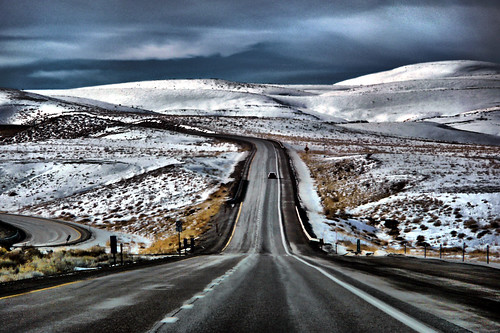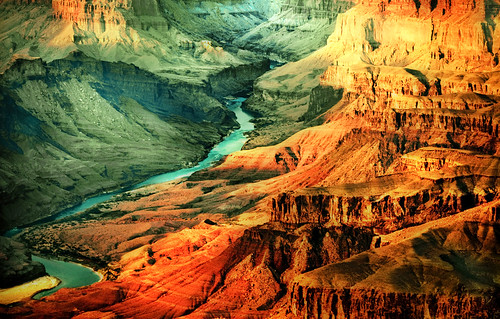Found this on Flick this evening when I really should have been doing homework, but oh well. I love images like this that create texture through the trees and their leaves. The contrast between the dark wood and bark and the light greenery is just fantastic. Enjoy.
Tag: environment
Quick Environment Links
TNR’s Environment and Energy blog has a list of links concerning some recent news about the environment. Check it out at the link below:
Quick Hits: So *That’s* Where The Trees Went Edition – Environment and Energy
battle mountain bound

battle mountain bound, originally uploaded by astrocruzan.
HDR images can sometimes be hit or miss. Many use the technique to a master level and create amazing images while others overdo it a bit. Here’s one I found on Flickr that I particularly like. The contrast between the road, sky, and snow is just great. Enjoy.
Re: Arctic Sea Ice
Another blog out there posted an entry that was very critical of the original Daily Tech and Boing Boing stories about Arctic Sea Ice levels that I posted about the other day. Among other charges, the post claims that:
You can see that there might be a downward trend, and any idiot (well, apparently not any idiot) can see that connecting two data points and drawing a conclusion about the trend, or what we might expect the future to bring, is … you get the idea.
In response to this article I posted a comment asking where the author got their graphs and information. The author responded by writing that:
[Response: I made the graphs myself using data available from the National Snow and Ice Data Center (there’s a link on the Climate Data Links page).
The stories reproduce a graph from Cryosphere Today, which shows the same trend. It’s just as significant statistically but not as evident visually, because the y-axis is on a much smaller scale so they can include more information on a single graph.
And there is a concensus on the issue — among those who know!]
This is exactly the problem that I have with any debates about climate change or global warming. The two extremes are just so set in their beliefs that they consider anyone who disagrees with their stance as an “idiot.” Each side picks some data composed of measurements, graphs, and “indisputable facts” that come from various organizations, etc. What neither one seems to realize is that they are picking the data that matches their viewpoint. With the multitude of sources out there for “facts” about global warming each side uses those that match their opinion and then decry everything else for being misleading and untrustworthy.
Furthermore, what gives either side the confidence that they can accurately predict what the climate and the Earth will do in 50 to 100 years? We got into this whole mess because those in control of industry believed that they could control and harness the power of nature to do their bidding without suffering consequences. Well, isn’t it just as misguided and egotistical to believe that we can predict the course of events in the natural world through computer models and an assemblage of “facts”? To me this falls into the same trap as the industrial greed that led us here.
Why does change need to be forced down people’s throats? I would like to see each side advocate for just living conscious and sustainable lives for the social and personal benefits that it brings and not feel the need to force this stuff upon people with tales of doom and gloom. If cutting carbon emissions and becoming more environmentally-friendly is truly as rewarding a change as some people claim then why can’t they argue for their position through positive claims? Instead of propounding the benefits each side resorts to threats and pessimistic proclamations as to why we must change now.
Stimulus money to national parks?
Daily KOS has an article detailing a recent report by the NPCA that asks from money from Obama’s economic stimulus package in order to revamp national parks. The author over at KOS writes that:
There are any number of things that could be done with the upcoming, huge stimulus package to put Americans back to work and and improve infrastructure. About $2.5 billion of that to go to our national parks, says the National Parks Conservation Association, and they have a plan.
This makes sense to me, and I would love to see the National Parks get money in order to properly maintain their services. What I am worried about is that maintenance would turn into expansion. I live right outside of Yosemite National Park and just cringe every time I drive through the valley. It’s one thing to make National Parks accessible and provide for simple accommodations, but that ought to be it. The amount of buildings, paved roadways, etc. in Yosemite Valley and other National Parks is just too bad.
This is what I am worried about seeing stimulus money go toward. If the NPCA wants money to maintain the current roads and buildings then that’s fine; however, if the money is intended for widening roads, building even more housing, and other forms of expansion, then I would have to say that I would be opposed to that. At some point we must realize that by accommodating everyone into a National Park we will simply lose what the park is there for: to protect the natural beauty of the place.
Link via Daily Kos: State of the Nation.
The Passive House
I do apologize for the glut of links to NY Times articles in the past few days, but I just keep finding interesting articles. Here’s one about energy efficient housing that is becoming popular in Germany and Scandinavia. The whole idea is that the house heats itself through what already gives off heat in the home. The discussion of the ventilation system is also great because it describes the genius ingenuity of the system. Here’s an excerpt below explaining the concept of a “passive house”:
The concept of the passive house, pioneered in this city of 140,000 outside Frankfurt, approaches the challenge from a different angle. Using ultrathick insulation and complex doors and windows, the architect engineers a home encased in an airtight shell, so that barely any heat escapes and barely any cold seeps in. That means a passive house can be warmed not only by the sun, but also by the heat from appliances and even from occupants’ bodies.
The Coal Ash Spill in Tennessee
Concerning the coal ash spill in Tennessee:
Authority officials initially said that about 1.7 million cubic yards of wet coal ash had spilled when the earthen retaining wall of an ash pond breached, but on Thursday they released the results of an aerial survey that showed the actual amount was 5.4 million cubic yards, or enough to flood more than 3,000 acres one foot deep. The amount now said to have been spilled is larger than the amount the Authority initially said was in the pond, 2.6 million cubic yards.
You would think that after so years and so many disasters ala Exxon Valdez companies would learn their lessons and go through every effort to try and assure that any toxic byproducts were well-contained. I just can’t imagine why a company (even a government-owned utility like the TVA) would risk the PR nightmare in order to save a little bit of money or cut a little corner.
What worse is that all these people living in the flooded area now have homes that are in a toxic epicenter. Even if the CEO of TVA relocates all the residents, which he claims he will, it still doesn’t replace the homes that were lost and the memories that can only be contained within them.
via Coal Ash Spill Is Much Larger Than Initially Estimated – NYTimes.com.

